

Compact Muon Solenoid
LHC, CERN
| CMS-PAS-FTR-21-011 | ||
| Search for leptophobic Z' resonances decaying to charginos in the dilepton plus missing transverse momentum final state at the HL-LHC | ||
| CMS Collaboration | ||
| March 2022 | ||
| Abstract: The prospects of a search for a massive leptophobic Z' decaying to a pair of charginos at the High Luminosity LHC at CERN is explored. The final state consists of two oppositely charged leptons and missing transverse momentum. The analysis is based on generated samples of proton-proton collision events at $\sqrt{s}=$ 14 TeV interfaced to the Phase-2 CMS Delphes detector simulation. A deep neural network is used for signal extraction. The expected signal sensitivity for a Z' with a narrow width is estimated. For an integrated luminosity of 3 ab$^{-1}$, Z' masses up to 4.4 TeV are expected to be excluded. | ||
| Links: CDS record (PDF) ; CADI line (restricted) ; | ||
| Figures | |

png pdf |
Figure 1:
Feynman diagram showing the signal process in this analysis: leptophopbic Z' decaying to two charginos, subsequently decaying to W and neutralino. |
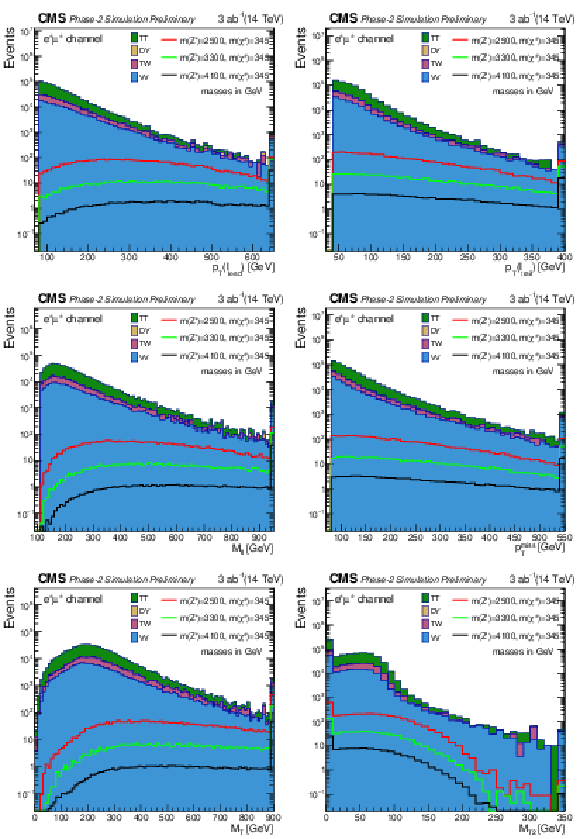
png pdf |
Figure 2:
Distributions of several event variables to be input to the DNN, after the event selection for the $e^\pm \mu ^\mp $ channel. |
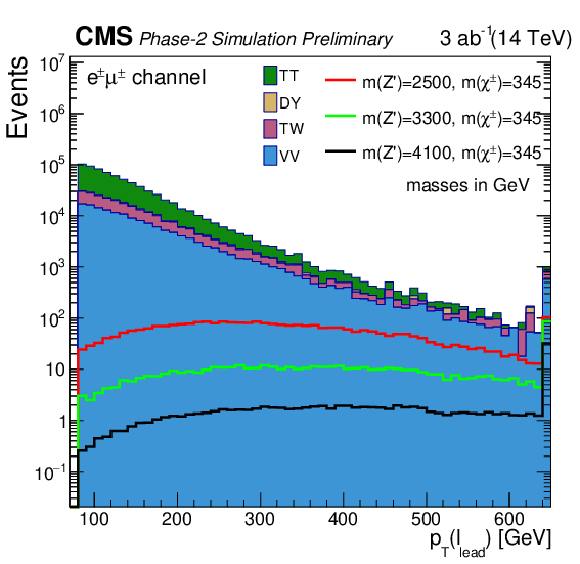
png pdf |
Figure 2-a:
Distributions of several event variables to be input to the DNN, after the event selection for the $e^\pm \mu ^\mp $ channel. |

png pdf |
Figure 2-b:
Distributions of several event variables to be input to the DNN, after the event selection for the $e^\pm \mu ^\mp $ channel. |

png pdf |
Figure 2-c:
Distributions of several event variables to be input to the DNN, after the event selection for the $e^\pm \mu ^\mp $ channel. |
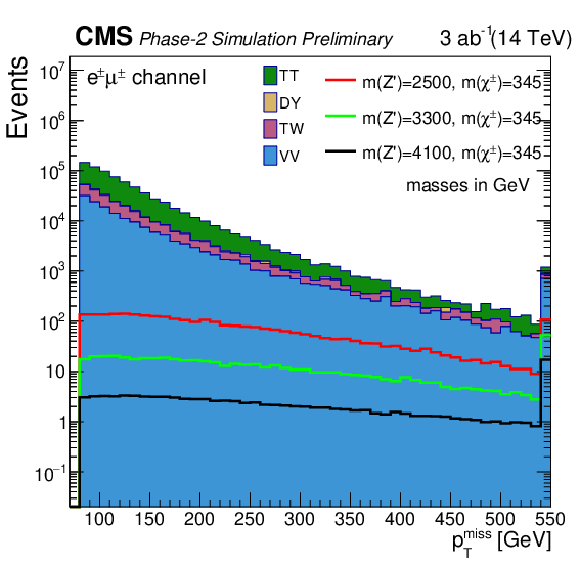
png pdf |
Figure 2-d:
Distributions of several event variables to be input to the DNN, after the event selection for the $e^\pm \mu ^\mp $ channel. |
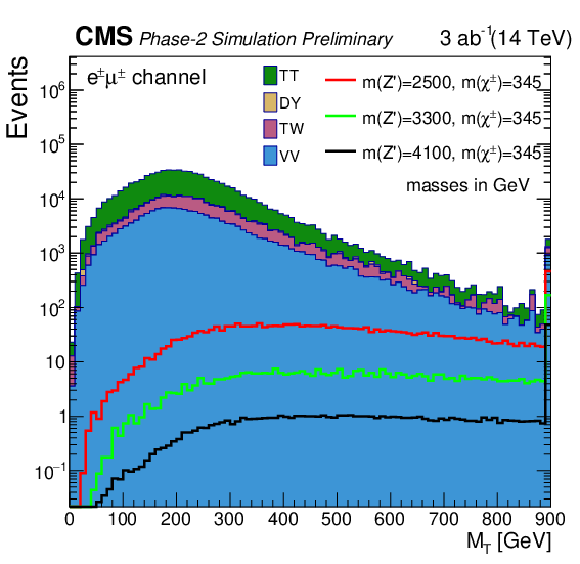
png pdf |
Figure 2-e:
Distributions of several event variables to be input to the DNN, after the event selection for the $e^\pm \mu ^\mp $ channel. |

png pdf |
Figure 2-f:
Distributions of several event variables to be input to the DNN, after the event selection for the $e^\pm \mu ^\mp $ channel. |

png pdf |
Figure 3:
Distributions of several event variables to be input to the DNN, after the event selection for the $\mu ^+\mu ^-$ channel. |

png pdf |
Figure 3-a:
Distributions of several event variables to be input to the DNN, after the event selection for the $\mu ^+\mu ^-$ channel. |

png pdf |
Figure 3-b:
Distributions of several event variables to be input to the DNN, after the event selection for the $\mu ^+\mu ^-$ channel. |

png pdf |
Figure 3-c:
Distributions of several event variables to be input to the DNN, after the event selection for the $\mu ^+\mu ^-$ channel. |

png pdf |
Figure 3-d:
Distributions of several event variables to be input to the DNN, after the event selection for the $\mu ^+\mu ^-$ channel. |

png pdf |
Figure 3-e:
Distributions of several event variables to be input to the DNN, after the event selection for the $\mu ^+\mu ^-$ channel. |
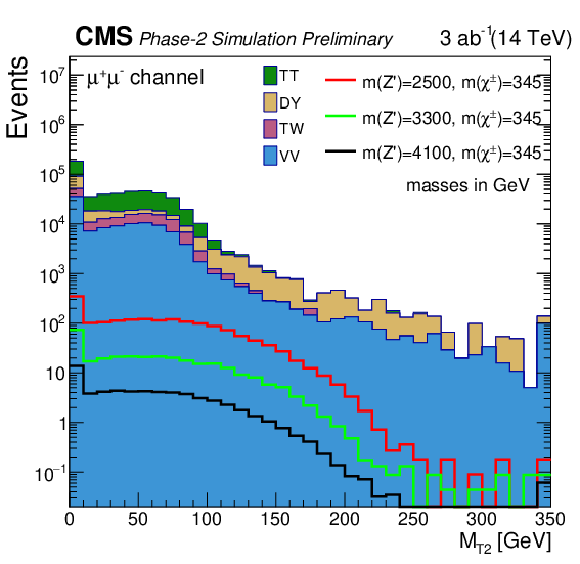
png pdf |
Figure 3-f:
Distributions of several event variables to be input to the DNN, after the event selection for the $\mu ^+\mu ^-$ channel. |

png pdf |
Figure 4:
DNN discriminant score distributions for the signal class in the $\mu ^+\mu ^-$ (top left), $e^+e^-$ (top right) and $e^\pm \mu ^\mp $ (bottom) channels for a signal point with a Z' mass of 2500 GeV and a $\tilde{\chi}^\pm _1$ mass of 1095 GeV. Effect of statistical and systematical uncertainties are also shown. The bottom panel in each plot displays the signal over background ratios. |

png pdf |
Figure 4-a:
DNN discriminant score distributions for the signal class in the $\mu ^+\mu ^-$ (top left), $e^+e^-$ (top right) and $e^\pm \mu ^\mp $ (bottom) channels for a signal point with a Z' mass of 2500 GeV and a $\tilde{\chi}^\pm _1$ mass of 1095 GeV. Effect of statistical and systematical uncertainties are also shown. The bottom panel in each plot displays the signal over background ratios. |

png pdf |
Figure 4-b:
DNN discriminant score distributions for the signal class in the $\mu ^+\mu ^-$ (top left), $e^+e^-$ (top right) and $e^\pm \mu ^\mp $ (bottom) channels for a signal point with a Z' mass of 2500 GeV and a $\tilde{\chi}^\pm _1$ mass of 1095 GeV. Effect of statistical and systematical uncertainties are also shown. The bottom panel in each plot displays the signal over background ratios. |
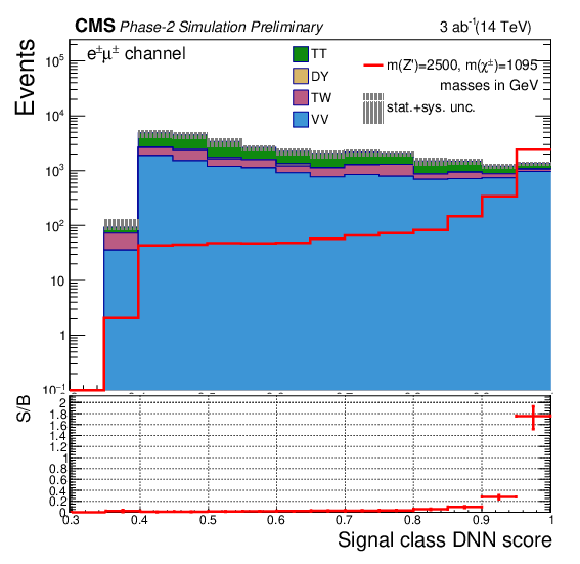
png pdf |
Figure 4-c:
DNN discriminant score distributions for the signal class in the $\mu ^+\mu ^-$ (top left), $e^+e^-$ (top right) and $e^\pm \mu ^\mp $ (bottom) channels for a signal point with a Z' mass of 2500 GeV and a $\tilde{\chi}^\pm _1$ mass of 1095 GeV. Effect of statistical and systematical uncertainties are also shown. The bottom panel in each plot displays the signal over background ratios. |

png pdf |
Figure 5:
The expected upper limits at 95% confidence level computed with the CLs method on the $pp \rightarrow Z'$ production cross sections are shown for $e^+e^-$ (top left), $\mu ^+\mu ^-$ (top right), $e^\pm \mu ^\mp $ (bottom left) and combined (bottom right) channels. Limits are calculated from the process Z' $ \rightarrow \tilde{\chi}^+_1\tilde{\chi}^-_1 \rightarrow W^+\tilde{\chi}_1^0W^-\tilde{\chi}_1^0 \rightarrow \ell ^+\tilde{\chi}_1^0\ell ^-\tilde{\chi}_1^0$. Z' width is considered to be approximately 1.5% of the Z' mass, neutralino mass is considered to be half the chargino mass and the Z' $ \rightarrow \tilde{\chi}^+_1\tilde{\chi}^-_1 \rightarrow W^+\tilde{\chi}^0_1W^-\tilde{\chi}^0_1$ branching ratio is considered to be equal to 1. Median expected CLs upper limits (95% CL) on Z' production cross sections are shown in the colored grid. The solid line denotes the median exclusion and the dashed lines denote the 68% interval. |

png pdf |
Figure 5-a:
The expected upper limits at 95% confidence level computed with the CLs method on the $pp \rightarrow Z'$ production cross sections are shown for $e^+e^-$ (top left), $\mu ^+\mu ^-$ (top right), $e^\pm \mu ^\mp $ (bottom left) and combined (bottom right) channels. Limits are calculated from the process Z' $ \rightarrow \tilde{\chi}^+_1\tilde{\chi}^-_1 \rightarrow W^+\tilde{\chi}_1^0W^-\tilde{\chi}_1^0 \rightarrow \ell ^+\tilde{\chi}_1^0\ell ^-\tilde{\chi}_1^0$. Z' width is considered to be approximately 1.5% of the Z' mass, neutralino mass is considered to be half the chargino mass and the Z' $ \rightarrow \tilde{\chi}^+_1\tilde{\chi}^-_1 \rightarrow W^+\tilde{\chi}^0_1W^-\tilde{\chi}^0_1$ branching ratio is considered to be equal to 1. Median expected CLs upper limits (95% CL) on Z' production cross sections are shown in the colored grid. The solid line denotes the median exclusion and the dashed lines denote the 68% interval. |
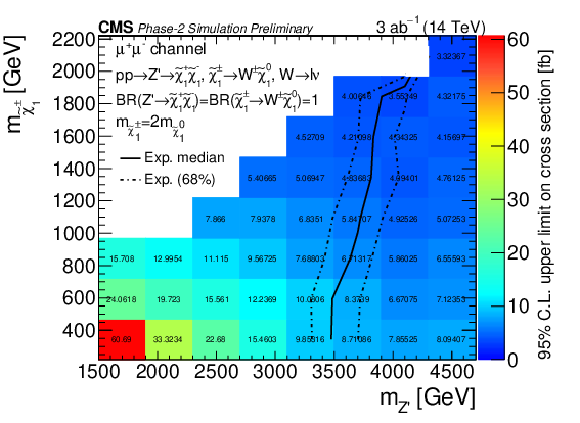
png pdf |
Figure 5-b:
The expected upper limits at 95% confidence level computed with the CLs method on the $pp \rightarrow Z'$ production cross sections are shown for $e^+e^-$ (top left), $\mu ^+\mu ^-$ (top right), $e^\pm \mu ^\mp $ (bottom left) and combined (bottom right) channels. Limits are calculated from the process Z' $ \rightarrow \tilde{\chi}^+_1\tilde{\chi}^-_1 \rightarrow W^+\tilde{\chi}_1^0W^-\tilde{\chi}_1^0 \rightarrow \ell ^+\tilde{\chi}_1^0\ell ^-\tilde{\chi}_1^0$. Z' width is considered to be approximately 1.5% of the Z' mass, neutralino mass is considered to be half the chargino mass and the Z' $ \rightarrow \tilde{\chi}^+_1\tilde{\chi}^-_1 \rightarrow W^+\tilde{\chi}^0_1W^-\tilde{\chi}^0_1$ branching ratio is considered to be equal to 1. Median expected CLs upper limits (95% CL) on Z' production cross sections are shown in the colored grid. The solid line denotes the median exclusion and the dashed lines denote the 68% interval. |

png pdf |
Figure 5-c:
The expected upper limits at 95% confidence level computed with the CLs method on the $pp \rightarrow Z'$ production cross sections are shown for $e^+e^-$ (top left), $\mu ^+\mu ^-$ (top right), $e^\pm \mu ^\mp $ (bottom left) and combined (bottom right) channels. Limits are calculated from the process Z' $ \rightarrow \tilde{\chi}^+_1\tilde{\chi}^-_1 \rightarrow W^+\tilde{\chi}_1^0W^-\tilde{\chi}_1^0 \rightarrow \ell ^+\tilde{\chi}_1^0\ell ^-\tilde{\chi}_1^0$. Z' width is considered to be approximately 1.5% of the Z' mass, neutralino mass is considered to be half the chargino mass and the Z' $ \rightarrow \tilde{\chi}^+_1\tilde{\chi}^-_1 \rightarrow W^+\tilde{\chi}^0_1W^-\tilde{\chi}^0_1$ branching ratio is considered to be equal to 1. Median expected CLs upper limits (95% CL) on Z' production cross sections are shown in the colored grid. The solid line denotes the median exclusion and the dashed lines denote the 68% interval. |

png pdf |
Figure 5-d:
The expected upper limits at 95% confidence level computed with the CLs method on the $pp \rightarrow Z'$ production cross sections are shown for $e^+e^-$ (top left), $\mu ^+\mu ^-$ (top right), $e^\pm \mu ^\mp $ (bottom left) and combined (bottom right) channels. Limits are calculated from the process Z' $ \rightarrow \tilde{\chi}^+_1\tilde{\chi}^-_1 \rightarrow W^+\tilde{\chi}_1^0W^-\tilde{\chi}_1^0 \rightarrow \ell ^+\tilde{\chi}_1^0\ell ^-\tilde{\chi}_1^0$. Z' width is considered to be approximately 1.5% of the Z' mass, neutralino mass is considered to be half the chargino mass and the Z' $ \rightarrow \tilde{\chi}^+_1\tilde{\chi}^-_1 \rightarrow W^+\tilde{\chi}^0_1W^-\tilde{\chi}^0_1$ branching ratio is considered to be equal to 1. Median expected CLs upper limits (95% CL) on Z' production cross sections are shown in the colored grid. The solid line denotes the median exclusion and the dashed lines denote the 68% interval. |
| Tables | |

png pdf |
Table 1:
Background samples used in the analysis. The samples for which a decay channel are specified are generated exclusively for that decay, while the others are inclusive in decays. |

png pdf |
Table 2:
Summary of object definitions and selections. |

png pdf |
Table 3:
Event selection and search channels. |

png pdf |
Table 4:
List of systematic uncertainties applied in this analysis, their values and their effects on signal and total background yields. Inclusive effects on yields are quoted for the signal region, considering the most conservative values from $e^+e^-$, $\mu ^+\mu ^-$ and $e^\pm \mu ^\mp $ channels. |
| Summary |
| A study was performed to predict the sensitivity of the HL-LHC to leptophobic Z' decaying to two charginos, which subsequently decay to W bosons and neutralinos. Leptophobic Z' are predicted in various extensions of supersymmetry. This is the first study of this model and process at the LHC. An analysis was designed in the dilepton plus missing transverse momentum final state, in the ee, $\mu\mu$ and e$\mu$ channels and performed on events simulated with the LH-LHC and Phase-2 CMS detector conditions. A deep neural network was employed to enhance signal sensitivity. The analysis was interpreted using simplified model spectra featuring the production and decay process of the leptophobic Z' derived from the U(1)' extension of the minimal supersymmetric standard model. Upper limits on the Z' production cross section were presented in the Z' mass versus chargino mass plane, with $m(\tilde{\chi}^0_1) = 2m(\tilde{\chi}^0_1)$ and Z' width assumed to be 1.5% of the Z' mass. With an integrated luminosity of 3 ab$^{-1}$, the combined analysis will be able to exclude Z' masses up to 4.4 TeV for decays into Z' $ \rightarrow \tilde{\chi}^+\tilde{\chi}^- \rightarrow W^+\tilde{\chi}^0_1W^-\tilde{\chi}^0_1$ with a branching ratio of 1. However, the excluded Z' masses will be smaller in full models with complete sparticle spectra, which will have lower branching ratios. |
| References | ||||
| 1 | CMS Collaboration | Technical Proposal for the Phase-II Upgrade of the CMS Detector | CMS-PAS-TDR-15-002 | CMS-PAS-TDR-15-002 |
| 2 | ATLAS Collaboration | Search for high-mass dilepton resonances using 139 fb$ ^{-1} $ of $ pp $ collision data collected at $ \sqrt{s}= $ 13 TeV with the ATLAS detector | PLB 796 (2019) 68--87 | 1903.06248 |
| 3 | CMS Collaboration | Search for resonant and nonresonant new phenomena in high-mass dilepton final states at $ \sqrt{s} = $ 13 TeV | JHEP 07 (2021) 208 | CMS-EXO-19-019 2103.02708 |
| 4 | CMS Collaboration | Search for high mass dijet resonances with a new background prediction method in proton-proton collisions at $ \sqrt{s} = $ 13 TeV | JHEP 05 (2020) 033 | CMS-EXO-19-012 1911.03947 |
| 5 | J. Y. Araz, G. Corcella, M. Frank, and B. Fuks | Loopholes in $ Z^\prime $ searches at the LHC: exploring supersymmetric and leptophobic scenarios | JHEP 02 (2018) 092 | 1711.06302 |
| 6 | M. Frank, Y. Hi\ccy\ilmaz, S. Moretti, and O. Ozdal | E$ _{6} $ motivated UMSSM confronts experimental data | JHEP 05 (2020) 123 | 2004.01415 |
| 7 | M. Frank, Y. Hi\ccy\ilmaz, S. Moretti, and O. Ozdal | Leptophobic $ Z^\prime $ bosons in the secluded UMSSM | PRD 102 (2020), no. 11, 115025 | 2005.08472 |
| 8 | CMS Collaboration | The CMS Experiment at the CERN LHC | JINST 3 (2008) S08004 | CMS-00-001 |
| 9 | CMS Collaboration | The Phase-2 Upgrade of the CMS Tracker | CMS-PAS-TDR-17-001 | CMS-PAS-TDR-17-001 |
| 10 | CMS Collaboration | The Phase-2 Upgrade of the CMS Barrel Calorimeters Technical Design Report | CMS-PAS-TDR-17-002 | CMS-PAS-TDR-17-002 |
| 11 | CMS Collaboration | The Phase-2 Upgrade of the CMS Endcap Calorimeter | CMS-PAS-TDR-17-007 | CMS-PAS-TDR-17-007 |
| 12 | CMS Collaboration | The Phase-2 Upgrade of the CMS Muon Detectors | CMS-PAS-TDR-17-003 | CMS-PAS-TDR-17-003 |
| 13 | CMS Collaboration | Expected performance of the physics objects with the upgraded CMS detector at the HL-LHC | CDS | |
| 14 | CMS Collaboration | Particle-flow reconstruction and global event description with the CMS detector | JINST 12 (2017), no. 10, P10003 | CMS-PRF-14-001 1706.04965 |
| 15 | D. Bertolini, P. Harris, M. Low, and N. Tran | Pileup per particle identification | JHEP 10 (2014) 059 | 1407.6013 |
| 16 | GEANT4 Collaboration | GEANT4--a simulation toolkit | NIMA 506 (2003) 250--303 | |
| 17 | CMS Collaboration Collaboration | B-tagging performance of the CMS Legacy dataset 2018. | ||
| 18 | C. G. Lester and D. J. Summers | Measuring masses of semiinvisibly decaying particles pair produced at hadron colliders | PLB 463 (1999) 99--103 | hep-ph/9906349 |
| 19 | A. Barr, C. Lester, and P. Stephens | m(T2): The Truth behind the glamour | JPG 29 (2003) 2343--2363 | hep-ph/0304226 |
| 20 | M. Abadi et al. | TensorFlow: Large-scale machine learning on heterogeneous systems | 2015 Software available from tensorflow.org. \url https://www.tensorflow.org/ | |
| 21 | F. Chollet et al. | |||
| 22 | X. Cid Vidal et al. | Report from Working Group 3: Beyond the Standard Model physics at the HL-LHC and HE-LHC | CERN Yellow Rep. Monogr. 7 (2019) 585--865 | 1812.07831 |
| 23 | T. Junk | Confidence level computation for combining searches with small statistics | NIMA 434 (1999) 435--443 | hep-ex/9902006 |
| 24 | A. L. Read | Presentation of search results: The CL(s) technique | JPG 28 (2002) 2693--2704 | |

|
Compact Muon Solenoid LHC, CERN |

|

|

|

|

|

|